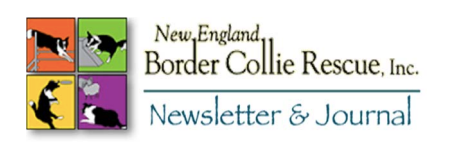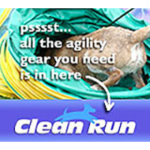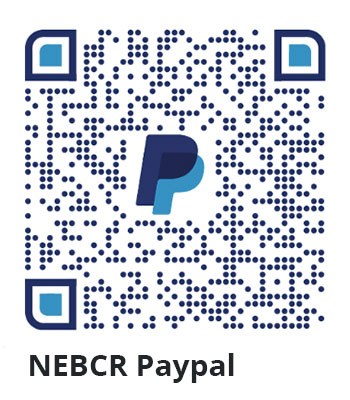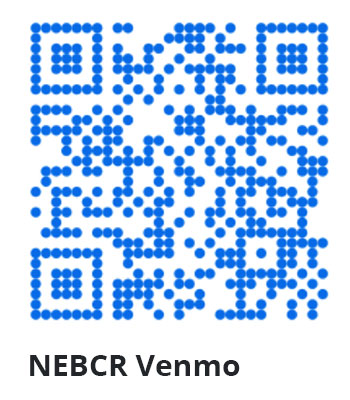Newsletter & Journal 2.4
VOLUME II NUMBER 4

Co-Presidents: Bea Hamm & Sarah Hepburn
Treasurer: Mo Clark
Secretary: Emily Wu
Board of Directors: Monique Fisher, Elise Gouge, Marie Hinds
Website: Rebeca Kerr & Monique Fisher
Editors: Bea Hamm & Rebeca Kerr
Please send your content and pictures to us at: nebcrnewsletter@gmail.com
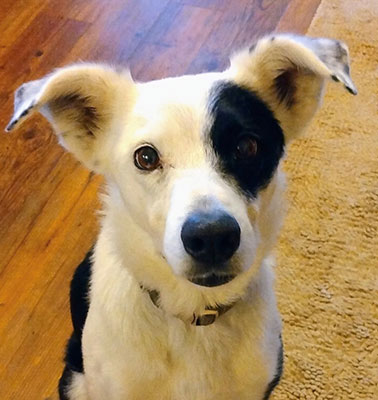
Featured: Molly
Do you own a cat?
If not, check out Molly she is looking for someone to love.
You’ll find her full bio here.
Introducing NEBCR member Sara Saperstein
by Sara Saperstein, MA, KPA-CTP, ANWI, FFC
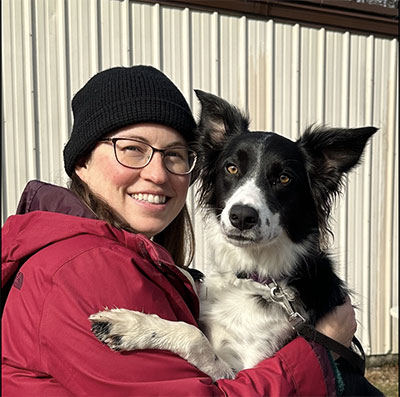
I’ve been volunteering with NEBCR since the summer of 2023. I do evaluations, transports, am on the applications committee, and am currently fostering. I’ve always loved border collies, and I “worked my way up” from a sheltie as my childhood dog, to an Australian shepherd as my first dog as an adult, to my current border collie, Adélie. She was picked up on the side of a highway when she was 4 months old and handed over to an Australian shepherd rescue. I had started sheep herding with my aussie Vegas before we had to stop due to him injuring his knee. It was enough to give me the herding bug and I very much wanted to get back into it. The rescue group contacted me: “You mentioned on your application that you wanted to do sheep herding. We have a border collie puppy, would you want her?” Um, YES!
When I adopted my previous dog Vegas, because he struggled with fear and avoidance, I read all the dog training books I could get my hands on: Karen Pryor, Patricia McConnell, Suzanne Clothier, and all the other greats at the time. We systematically tackled his fears and in a handful of years no one would have guessed he had ever struggled. But there weren’t many dog sports back then, and Vegas was happy to be an outdoorsy dog: hiking, skijoring, and kayaking, and lots of food puzzles, so that’s what we did. Unfortunately we never found a second dog that fit our family so he remained an only dog.
When I adopted Adélie I jumped back into updating my dog training knowledge and was so pleased to see there had been substantial progress in dog training knowledge and technique. I dove into books and podcasts but wanted more, and Adélie being a sensitive dog required me to level up my training skills, so I went through the Karen Pryor Academy Dog Training Professional program to earn a professional dog training certification (KPA-CTP). Since then I have also started working towards a certification in nose work through the National Association of Canine Scent Work (NACSW) and I’m currently an associate nose work instructor (ANWI) teaching nose work classes in Boston. Feeling strongly about fear free training I became a certified professional (FFCP) trainer and will be teaching a cooperative care course starting this fall.
Adélie’s a very busy dog and loves sports, so we started picking up sports, one after the other. We currently compete in nose work, ratting, dock diving, and disc dog. We are training to compete in herding, agility, and flyball. We also do canicross and participate in research at Boston College and Harvard, and join tracking practice whenever we can squeeze it into the schedule. It’s a lot, but every time I try to think about what we can cut out, Adélie convinces me that she loves them all too much and couldn’t possibly give any of them up. Lucky for her I’m currently in between jobs right now, as a leader in data science and AI, so I have a lot of time to keep her occupied. That also means I have plenty of time to foster. We recently fostered Fred who was placed with an absolutely amazing home. And we just started our second foster, Archie. I’m looking forward to sharing updates about Archie and setting him up for success in his future forever home.
So, You Think You Want a Border Collie?
by Kerry Maloney
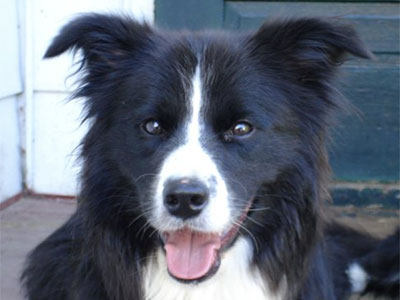
Over the years, I’ve been lucky enough to take my border collies with me at times when I have travelled. The first time I was on the road with Dublin, my first border collie, was a bit of a learning experience. I was going to be travelling for work for a few weeks at a time, and while I wasn’t really allowed to take my dog with me, my boss was ok with it as long as we didn’t tell anyone. He needed me to go on the trip and I wasn’t about to pay to board my dog for three weeks as that was a huge expense for someone just starting out in their career. Luckily, it was the winter, and I was going to be mostly working out of my car as I visited various sites. Dublin loved riding in the car and would happily curl up and snooze for the 30-40 minutes I was at each stop. And I definitely enjoyed having company on what would otherwise be a boring three weeks.
It would be Dublin’s first time in a hotel, but I wasn’t too worried. He was a well-behaved dog and a trained therapy dog by that point, so he was used to going to new places. What he had never experience, however, was an elevator. Dublin was already a little on edge because we were in Long Island, a land with way more noise and traffic than he (or I) appreciated. Dublin behaved beautifully as we checked in and then he walked with me to the elevator. The door opened and I walked in while Dublin hesitated for a second, clearly confused as to why we were walking into a closet but after a second, he gamely followed me in and turned to sit in heel position by my side as the doors closed. We got to our floor, the doors opened, and we started to walk out and Dublin stopped dead. He backed up and looked around….this wasn’t where we were a second ago and he wanted nothing to do with this dark magic. It took some persuading, but he eventually walked out to our floor, and we made it to our room. Sometimes having a dog so aware of their surroundings isn’t the easiest thing.
After a few days, Dublin was a pro with the dark magic of the elevator. He remained uneasy with all the traffic noise (our hotel was right off a major highway) and he had still refused to go to the bathroom. He was too on edge and unlike my current female border collie, who immediately claims all new land as hers (I swear she marks more than all of my previous male dogs combined – even lifts her leg to do it!), Dublin was hesitant to mark this new place. I would routinely walk him and bring him down from our hotel room to stand by the few trees in the “dog area” but Dublin wasn’t having any of it. By the third day, I was getting a bit desperate and was refusing to go back inside until he had done his business. We were standing out there on the snow-covered ground, me stubbornly refusing to leave until Dublin did his business, and Dublin wondering when we could leave this place and go back home. Dublin finally caved and lifted his leg on the nearby tree. I was so relieved! Until I noticed he didn’t lift his leg that long, and as he had been eating and drinking normally the past few days, I had to imagine he had a pretty full bladder. I inspected the tree, and thanks to the snow cover, it was easy to determine Dublin had fake peed in an effort to end our stalemate. I walked him to the other tree, and he looked at me, lifted his leg for a second and again pretended to pee and then turned to walk back inside. I was flabbergasted. I couldn’t believe he was trying to fake me out. At this point, I gave up and we went back inside. Dublin won that match. I was determined to win the war though, because I was getting concerned about the state of his bladder.
The next morning, we left the hotel very early in a futile attempt to beat the Long Island traffic. I was determined to find a relatively quiet park or walking trail without a ton of traffic noise. This was before the days of smart phones and being able to immediately google what you needed. I ended up speaking to a municipal worker I stumbled upon in a (still too loud for Dublin) park and he directed me to a dog park a few miles further out. It was one of the nicest dog parks I’ve ever seen to this day. It was a few acres of fenced in field and woods and more importantly, it was quiet…especially at 6:30 in the morning. I let Dublin off-leash, and he immediately took off into the woods after a squirrel. He was in heaven! After his unsuccessful squirrel hunt, he came prancing back to me and we started walking through the wooded area and he marked everything in sight! Woohoo! Success! I never thought I would be so thrilled to have a dog go to the bathroom but living with a border collie is sometimes a wild ride.
For the rest of our stay, I made sure we started and ended our day at that dog park, and if everything wasn’t right in his world, it at least made it more tolerable until we returned to the peace and quiet of our home. Dublin became a great travel dog and while he never loved being in high-traffic areas, he did learn to take them in stride.
Gorgeous 2025 NEBCR calendar available NOW!
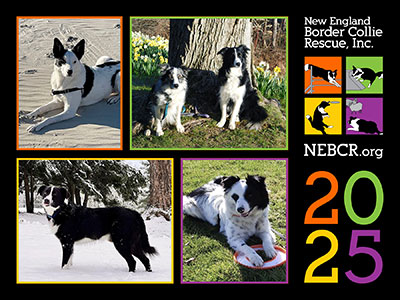
Each month is like a mini celebration featuring one of our alumni.
You not only have a beautiful Border Collie to grace our walls for the month but a story to see the difference NEBCR and a wonderful adopter has made in their life.
All proceeds go directly to helping more Border Collies in need. Here is a direct link to the order form.
No Regrets
by Jenny and Tim Sullivan
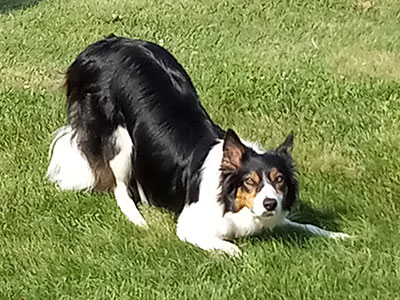
Our love affair with Border Collies goes back to 1999, when we adopted our first BC mix, Tucker. We have always had Border Collies or BC mixes and always adopted from rescues. In April 2022, we moved across the country from Denver to New Hampshire with our Lucy girl (Border Collie/Australian Cattle Dog mix adopted from Herdings Rescue Dogs of Wyoming) copiloting from her throne in the back seat. In September 2022, we lost our sweet Lucy to epilepsy and heart failure. Sadly, we found ourselves dogless for the first time in almost 25 years.
Our veterinarian, also a BC lover, recommended we check out New England Border Collie Rescue. As we perused the dogs available for adoption, there was a beautiful tricolor with the silly name of Butterball whose picture and story kept drawing us back. He had been diagnosed with epilepsy at a young age. Because we had experience with an epileptic dog in Lucy, we decided to see if we might be a good match for Butterball. We submitted an application and then were scheduled for a home visit. We live in a condo with no ability to fence a yard, so we were concerned about that, but our evaluator didn’t seem to think it would be a problem with the right dog. We had several long talks with Butterball’s foster mom, explaining our situation to her, and she felt he might be a good match for us. We brought him home on December 7, 2022.
Now known as Ronan, our lovely new dog began to settle in with us. His epilepsy had been well regulated on new medications during his time with his foster family. He hadn’t had a seizure in nearly 6 months when we got him. As he settled in, more of Ronan’s personality began to surface. He had been described as fairly moderate energy, not interested in toys or playing very much, and very sweet. With us, he turned out to be very energetic, a complete toy and ball hound, and a very sweet snuggler. Because we don’t have a fenced yard, we went on numerous walks a day, and discovered new places to explore all over our new home town and region. As his recall developed with us, we were able to take him to several of the large fields in our development to play ball off leash, and many of our neighbors commented on how much they enjoyed seeing him racing around. They were impressed with his athleticism and grace. He also loved to play in the snow. His rough coat offered him some protection from the cold, so he’d gallop through big snow banks and burrow in the fresh snow behind our house.
Ronan had his first cluster of seizures with us when we’d had him for just a few months. If you’ve never seen a dog having a seizure, consider yourself lucky. It is a devastating thing to witness when his little body would become rigid and convulsive. Unfortunately, we discovered Ronan didn’t just have one seizure, he seized in clusters. Each time, we would run him to the emergency vet, where they were always able to stabilize him. We would increase his dose of Keppra ER, and that seemed to work for several months each time. In between seizures, Ronan was his normal self. He was energetic and happy and an avid foodie. He was very treat motivated, so we had started to work on some tricks and puzzles, which he picked up on right away. Such a smart boy!
Unfortunately, as time went on, Ronan’s seizures were lasting longer and were harsher. We had emergency medications we could give to him to help stop the seizures, but they started to take longer to work and he needed more doses. In late January 2024, Ronan had his worst cluster of seizures to date, so we rushed him to the emergency vet. This time, it took them longer and they had to use more methods to get his seizures to stop, but we finally got the call on February 1 that he had been seizure free for 12 hours and we could come get him.
Ronan rushed to greet us in the lobby and, to our amazement and joy, we both got sweet kisses on the face from him. He had never done that before! We loaded him up in the car, overjoyed to be heading home, and were not 2 miles from the hospital when he had another seizure in the back of the car. We immediately returned to the hospital, where they rushed Ronan back to treatment and the vet came to have a difficult discussion with us. It was clear that he had reached a new point in his battle with epilepsy. He would need to be on as many as four different anti-seizure medications, with no guarantee that this would keep him from seizing more frequently. It was clear that it was time to let him go. We spent a couple of hours hanging with him and stuffing him with his favorite cookies, then said goodbye to our best boy.
Ronan taught us many lessons in the 13 months we got to share with him. We have no regrets about adding him to our family even though our time with him was so short. He brought so much love, laughter, and joy to our lives. We miss his sweetness and silliness still and we feel the presence of his absence. We’re still healing from this loss, but there may be another BC in our future.
Time will tell…
ASK THE VET: Understanding and Managing Soft Tissue Injuries and Lameness
by Dr. Sarah Hepburn
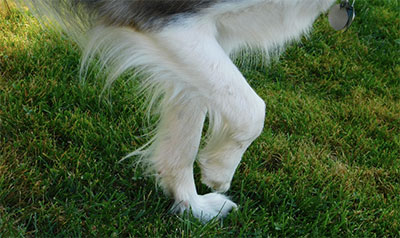
In pets soft tissue injuries and lameness are a common concern and can significantly impact mobility and overall quality of life.
Recognizing these issues early and managing them properly is essential for a swift recovery.
Recognizing Soft Tissue Injuries and Lameness: Soft tissue injuries involve muscles, tendons, or ligaments and can result from trauma, overexertion, or repetitive strain. Symptoms to watch for include limping, reluctance to walk or play, swelling, and signs of pain such as whining or panting. If your dog is hesitant to put weight on a limb or shows stiffness after rest, these may be indications of an injury.
Preventing Injuries: Preventing soft tissue injuries involves regular, age-appropriate exercise and careful management of activity levels. For young, active pets, activities should include play sessions that balance high-energy bursts with rest periods. Avoid excessive jumping or rough play that could lead to injuries. For older pets, focus on low-impact exercises such as gentle walks and swimming, which are easier on the joints and muscles.
When to Seek Veterinary Care: If you notice signs of lameness or suspect an injury, consult your veterinarian promptly. Delaying treatment can lead to worsening of the condition and prolonged recovery. Your vet will conduct a thorough examination, possibly using imaging techniques like X-rays or ultrasounds, to diagnose the injury and recommend a treatment plan.
Treatment and Recovery: Treatment for soft tissue injuries typically involves strict rest and exercise restriction. This means confining your pet to a small area or crate to minimize movement and prevent further strain, and avoiding off leash exercise, rough play, running, jumping and stairs. During the initial recovery phase, your vet may also suggest cold packs to reduce swelling and pain. Once the acute phase has passed, your vet may recommend a controlled physical therapy program to aid recovery. Follow the prescribed exercise plan closely to ensure proper healing. Do not administer any over-the-counter pain medications or any drugs that were not specifically prescribed by your veterinarian for the injured dog.
Age-Appropriate Exercise Puppies and Young Dogs: Young dogs are often very active and require regular exercise to support their growth and development. They thrive on energetic play but should be monitored to avoid excessive jumping or running that could strain developing muscles and joints. Engage them in controlled interactive play sessions that are balanced with rest periods. Avoid high-impact activities like jumping from heights or running on hard surfaces that can stress their developing joints and muscles. Focus on low-intensity play that encourages gentle movement.
Adult Dogs: Moderate exercise is key. Activities like regular walks, fetch, and agility training should be adjusted to avoid overexertion. Ensure they have warm-up and cool-down periods to prevent sudden injuries.
Senior Dogs: Focus on low-impact activities to maintain mobility and muscle tone. Short, gentle walks, swimming, and low-impact agility exercises are beneficial. Avoid high-impact activities that could stress aging joints and muscles.
Exploring K9 Nose Work and it’s Benefits
by Gina Baker, CNWI
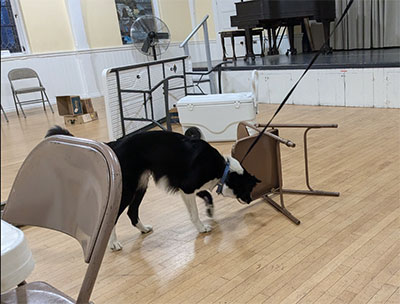
What is K9 Nose Work?
K9 Nose Work is a great fun activity/sport of scent detection inspired by Ron Guant, Amy Herot & Jill Marie O’Brien, to emulate real life tasks performed by professional detection dogs.
To begin nose work, we want to get your dog excited using their amazing nose to search out a treat or a favorite toy hidden in one of several boxes.
The game expands by adding boxes, creating different scent puzzles using various combinations, environments and surfaces within interior, exterior, container, and vehicle searches. The foundation of NACSW methodology utilizes boxes for context but as your dog becomes confident target odors can be introduced to take the game to the next level.
What are the benefits of Nose Work?
Intro to Nose Work is an obedience free activity, meaning there is no handler’s interference or correction, which in turn allows the dogs to work one at a time off leash in a secure area providing stimulation while building confidence by self-rewarding, independence, focus, hunting skills, and problem solving. The activity is especially beneficial for shy and reactive dogs. It provides both mental and physical enrichment for all dogs and their owners including the physically challenged. We all know that a tried dog is a good dog!
Proof is in the pudding! I have taught K9 Nose Work the NACSW methodology since 2012 and have had numerous dogs come through my Intro to Nose Work class and have seen the benefits of Nose Work up close, one dog in particular will always stay with me.
She was (is) a Vizsla, a hunting breed. The first class, she was so scared, her owners had to physically drag her into class, tail between her legs, and peed everywhere. Her owners were beside themselves. Plus, I could tell that the male owner was a bit heavy handed with her. My heart went out to her. I told them not to worry, we can always clean the floors. I convinced them to continue with the class, she just needs time. It took a couple weeks for her to begin searching but she did! Each week she peed less, her tail was a little higher, she was building confidence and having FUN! She completed the Intro to Nose Work class with flying colors, onto Intro to Odor. She became a Super Star! After 18 weeks, that scared nervous dog that had to be dragged into class was a confident happy dog that had to be dragged OUT of class! Not to mention how proud the owners were. I also saw a change in how the male owner interacted with her, in a good way. Her owners still play the game with her.
Benefits of Nose Work not only touch the dog’s life it also extends to the handler. The handler learns to read their dog’s body language which in turn creates a better understanding leading to bonding and building teamwork.
An additional benefit, Nose Work is portable and fairly inexpensive. Being dog owners, it seems like there are always chewy boxes available and treats in our pockets. During the years of my beloved reactive dog Kalli, (who got me involved in Nose Work) I would always travel with several boxes in my car. We would stop at parking lots, parks, on the side of the road any place that was new or could be scary, boxes came out, we would do a couple searches, then continue our way.
Nose Work offers endless possibilities to give your dog mental stimulation, physical exercise where the benefits are invaluable whether you just play the game for fun or compete in the sport.
Let’s start collecting those boxes and play the game!!
TRAINER’S CORNER: Out and About
by Elise Gouge, CPDT, CABC Certified Behavior Consultant & Trainer
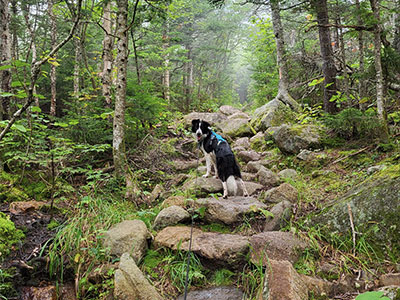
Anyone who loves border collies surely loves the active lifestyle that comes with owning one. Hiking, camping, water sports – is there anything a border collie can’t do?! At the same time, so many border collies are sensitive, dog-selective, and not a fan of having strange dogs run up to them on trails or out on walks.
Recently, a journalist interviewed me regarding off-leash laws. She asked me for tips and advice on training, handling situations safely, and the pros and cons of leash laws. It’s a topic I’m passionate about and I had to really reel it in for the interview!
I have seen many sensitive border collies develop reactivity issues because of challenging encounters with off-leash dogs. It only takes a few interactions for a border collie to decide unknown dogs are a threat. At the same time, losing the privilege of off-leash romps can be so limiting and really impact the exercise and overall well-being of a dog. So what’s the answer? Read on to see what I discussed with Emilee and I’d love to hear your thoughts about it, too!
Successful Summer for NEBCR
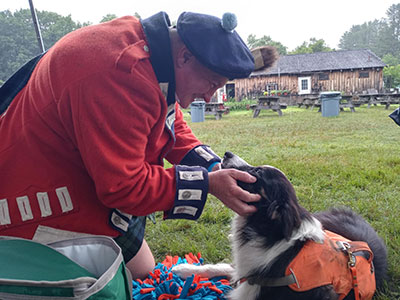
We had a busy summer holding events, auctions and demos at two Highland Games. First I would like to thank everyone that volunteered to help out making these fundraisers possible. NEBCR has so many awesome supporters donating items for the auction or raffle at our Reunion, my thanks to them as well.
A special thank you to Barb Fribourg for breathing life back into the auction. This is a huge commitment taking a lot of preparation and follow through. Barb brought in $2856 of much needed funds to support our rescue in covering the medical needs for dogs we bring in.
The NEBCR Reunion held in August took place on a beautiful sunny day despite a few days earlier we had the prediction of the remnants of a hurricane passing thru. All who attended can attest to a fun filled day with our two and four footed friends. Another shout out to our gracious hosts Craig and Kathy Chittenden at Sugar Bush Farm for hosting. Sugar Bush magic at work bringing new and old friends together to enjoy the day. This event brought in a total of $2232! Please take note Aug. 9/10 2025 is the date for our next Reunion. It will be our 25th year as a rescue. I’m looking forward to it already!
This summer NEBCR was asked to do two demos at the Highland Games in ME and NH. It makes for a long day but so rewarding. It’s not only a great PR event but allows us to educate as well. We brought in a total of $2310 for these two events making well worth the effort.
Of course a big part of having a successful summer is all the dogs we have helped find homes for and others brought into rescue getting ready to find their forever homes. You, our supporters and volunteers make miracles happen everyday. Forever grateful…
